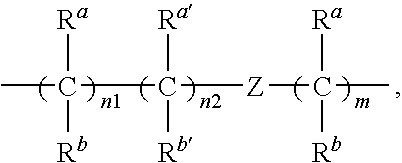Renin Inhibitors
a renin inhibitor and renin technology, applied in the field of renin inhibitors, can solve the problems of insufficient soluble renin inhibitors that can be prepared on a large scale, high cost of goods, and the inability to develop several compounds in clinical trials, etc., and achieves low molecular weight, high in vitro activity, and high cost of goods.
- Summary
- Abstract
- Description
- Claims
- Application Information
AI Technical Summary
Benefits of technology
Problems solved by technology
Method used
Image
Examples
preparation b
methyl 2-(1-(5-chloro-2-methylphenyl)-3-(methylamino)propoxy)ethylcarbamate
[0341]
Step 1. tert-butyl 3-(5-chloro-2-methylphenyl)-3-oxopropyl(methyl)carbamate
[0342]To a solution of 2-bromo-4-chloro-1-methylbenzene (25 g, 0.123 mol) in anhydrous THF (150 mL) at −78° C. under N2 was added drop wise a solution of n-BuLi (2.5 M, 49 mL, 1.18 mol). After stirring at −78° C. for 1 h, a solution of tert-butyl 3-(5-chloro-2-methylphenyl)-3-oxopropyl(methyl)carbamate (26 g, 0.104 mol) in anhydrous THF (150 mL) was added drop wise. After addition, the reaction mixture was allowed to warm to room temperature and stirred overnight. The mixture was quenched with saturated NH4Cl, extracted three times with ethyl acetate, and dried over Na2SO4. Solvent removal and flash column chromatography afford tert-butyl 3-(5-chloro-2-methylphenyl)-3-oxopropyl(methyl)carbamate (3.3 g, yield 9%). 1H NMR (CDCl3, 400 MHz) δ 1.44 (s, 9H), 2.45 (s, 3H), 2.90 (s, 3H), 3.10 (m, 2H), 3.60 (m, 2H), 7.10 (m, 3H).
Step 2. t...
preparation d
3-(3-chlorophenyl)-N-isopropyl-3-(3-methoxypropoxy)propan-1-amine
[0357]
Step 1. 3-(3-chlorophenyl)-N-isopropyl-3-(3-methoxypropoxy)propan-1-amine
[0358]3-methoxypropyl methanesulfonate was prepared using procedures described in U.S. Prov. App No. 05 / 036,230 (PCT App No. 60 / 616,770).
[0359]tert-butyl 3-(3-chlorophenyl)-3-hydroxypropyl(isopropyl)carbamate was obtained using procedures analogous to Preparation A, Steps 1-6, using isopropylamine in Step 1 and NaBH4 in Step 6. To a 0° C. solution of tert-butyl 3-(3-chlorophenyl)-3-hydroxypropyl(isopropyl)carbamate (158 mg, 0.48 mmol) in THF (5 mL) was added NaH (60 mg, 1.45 mmol) and the reaction was allowed to stir for 5 minutes. 3-methoxypropyl methanesulfonate (810 mg, 4.8 mmol) was then added and the reaction was heated to reflux for 2.5 hrs. After cooling to room temperature, the reaction was quenched with saturated ammonium chloride solution at 0° C. The aqueous layer was extracted with EtOAc (2×). The combined organic layers were dri...
example 1
methyl (4S,10R)-10-(3-chlorophenyl)-4-(cyclohexylmethyl)-7-methyl-6-oxo-11-oxa-2,5,7-triazatridecan-13-ylcarbamate
[0415]
Step 1. tert-butyl (S)-2-(3-(3-(2-(methoxycarbonylamino)ethoxy)-3-(3-chlorophenyl)propyl)-3-methylureido)-3-cyclohexylpropyl(methyl)carbamate
[0416]At 0° C., CDI (48.6 mg, 0.3 mmol) was added to a solution of (S)-tert-butyl 2-amino-3-cyclohexylpropyl(methyl)carbamate (81 mg, 0.3 mmol), prepared using procedures described in U.S. Prov. App No. 05 / 036,230 (PCT App No. 60 / 616,770), and DIEA (161 mg, 1.25 mmol) in anhydrous CH2Cl2 (8 mL) followed by stirring for 1 h. The solution was added to methyl 2-(1-(3-chlorophenyl)-3-(methylamino)propoxy)ethylcarbamate (75 mg, 0.25 mmol) in anhydrous CH2Cl2 (4 mL). The reaction mixture was allowed to warm to room temperature and stirred overnight. After the reaction was completed, the solvent was removed in vacuo. The product was purified with preparative TLC to afford tert-butyl (S)-2-(3-(3-(2-(methoxycarbonylamino)ethoxy)-3-(3-c...
PUM
 Login to View More
Login to View More Abstract
Description
Claims
Application Information
 Login to View More
Login to View More - R&D
- Intellectual Property
- Life Sciences
- Materials
- Tech Scout
- Unparalleled Data Quality
- Higher Quality Content
- 60% Fewer Hallucinations
Browse by: Latest US Patents, China's latest patents, Technical Efficacy Thesaurus, Application Domain, Technology Topic, Popular Technical Reports.
© 2025 PatSnap. All rights reserved.Legal|Privacy policy|Modern Slavery Act Transparency Statement|Sitemap|About US| Contact US: help@patsnap.com



